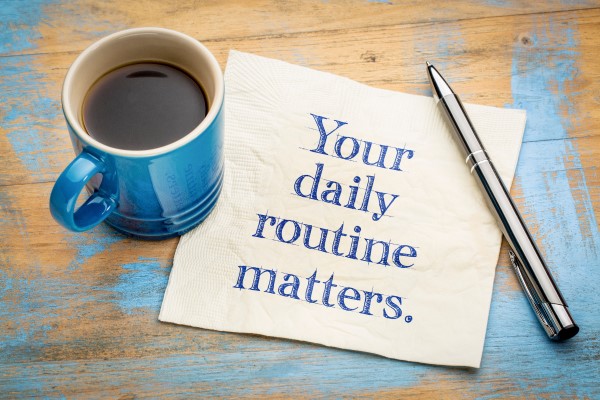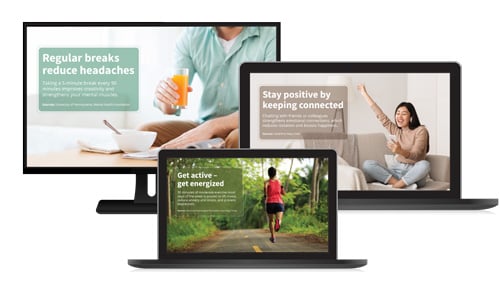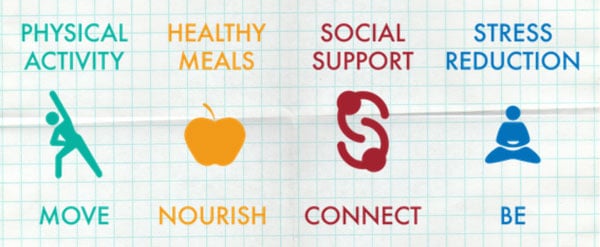
Humans are social animals. Take away our ability to readily engage with others and we feel disconnected and trapped.
For many of us, the current working environment due to COVID-19 can feel a little bit like a prison. Our bubbles are our cells.
Work is stressful, even under normal conditions. Research by the American Psychological Association revealed that 64% of employees list their work as the number one stressor in their life. That’s why one million workers in the United States miss work every day due to stress.
But combine this with the unfamiliar demands and restrictions of remote working and social isolation, and the potential for more serious and sustained mental health issues is increased. Early studies on the impact of COVID-19 already warn of the potential for a mental health crisis.
Employers play an important role in employee wellness communication which helps staff deal with stress, anxiety, and fear in these times. Here are some good habits and mindsets, based on recommendations by health and psychology professionals, that HR Managers can promote to help employees build a positive mental outlook and positively impact psychological health.
1. Set routines
Feeling in control is a core part of our psychological resilience. But today’s disrupted working environments and restricted movement reduce our feelings of control over our situation. The absence of the usual daily structure we rely upon can reduce predictability and certainty.
Routines instill a sense of purpose and provide valuable structure. Encourage employees to set routines for key parts of their day – both work-related and personal.
Set a time each day for necessary ‘housekeeping’ tasks, such as desktop research, checking system integrity or updating task management boards. Schedule regular check-in times with teammates to discuss shared projects or interests. Setting – and sticking to – these routines become valuable waypoints in each day.
This principle is equally effective in the home. Encourage employees to set routines around working and playing for them and their family. A clinical psychologist writing in the Washington Post advises planning times for everything, while understanding the need to be flexible and adapt as required.

2. Practice self-care
Self-care is that mix of nutrition, exercise and socialization that grounds us and keeps us fully equipped to handle situational stresses. Taking care of yourself is important for physical health but is also a valuable affirmation of your own self-worth. It’s the reverse of wallowing on the couch with a box of chocolates when you’re feeling down.
Businesses can improve workplace mental health by promoting good self-care to their employees through corporate screensaver messages, like the examples shown below. Examples of good employee wellbeing and mental health messages to promote include:
- Fresh air and exercise is proven to sharpen your mind and improve psychological health.
- Staying hydrated lifts alertness and reduces tiredness.
- Speak with family and friends regularly for social connection and stimulation.
Self-care also underlies many of the recommendations issued by the World Health Organization in their coping with stress during COVID-19 infographic.

3. Use humor
We’ve all heard the saying that laughter is the best medicine. While not intended to be taken literally, psychologists still recommend humor as a powerful coping mechanism in times of crisis. For example, the Fox News anchor who tweeted:
“How long is this social distancing supposed to last? My husband keeps trying to get into the house.”
The use of humor, or indeed any light-hearted content, should be considered in your HR communications. Over the last few weeks employees will have been bombarded by a series of internal communications often negative in tone – remote working, social isolation, changes to business operations, maybe even redundancies.
Failing to provide some balance results in anxiety, negative mindsets, lower productivity and poorer quality of work. Just be mindful that humor still needs to be in good taste.
Here are some examples of workplace humor that employees can participate in:
- Share their favorite jokes
- Nominate a colleague for quote of the day
- Suggest a light-hearted fail of the week (for example, the author of this article once worked for a hotel chain and one day asked a colleague where to find the Lobby Bar… oh dear!)
4. Reflect and appreciate
The busyness of our lives and preoccupation with what’s happening in the moment often cause us to neglect important time reflecting on what we’ve achieved. For employees, fixating on problems or what remains to be done fosters stress and a feeling of low achievement.
Encourage employees to spend time reviewing what they’ve accomplished at the end of each day – either on their own or in their teams. Devoting time to this reflection provides positive affirmation of their efforts and boosts their sense of self-worth.
This is also something that can be practiced at home. The restrictions on movement currently in place offer an opportunity for everyone to form deeper relationships with family or housemates, reevaluate what things we do give us happiness, and appreciate what we have. Consider the words of Chinese philosopher Lao Tzu:
“Be content with what you have; rejoice in the way things are. When you realize there is nothing lacking, the whole world belongs to you.”
This reflection on our achievements and appreciation of what we have improves our psychological growth, and is part of the Be component of the “Universal Prescription” recommended by behavioral health and wellness initiative Open Source Wellness.
 Source: Open Source Wellness
Source: Open Source Wellness
5. Switch off
When Dolly Parton sang about working 9 to 5 she certainly didn’t have today’s working model in mind. Knowledge workers today regularly work longer hours, often checking and responding to emails during evenings and weekends. The widespread adoption of working from home due to COVID-19 has only exacerbated this.
But use of digital devices are proven to interfere with everything from sleep to creativity. It’s important that HR Managers encourage all staff to schedule screen-free times away from their computer to give their eyes and mind a rest. These should include both 5-10 minute mini-breaks every 90 minutes, plus longer breaks for lunch and at mid-morning and mid-afternoon (or the equivalent for shift workers).
Switching off in this way allows your brain to reset, rather than constantly running in the background like a computer. Shutting your brain down from work at the end of the day should feel like your laptop shutting down with a contented silence.
Mental health in the workplace is one of the fastest-growing issues for businesses today. The onus is on employers to act responsibly for the welfare of their staff. Encourage positive practices and techniques like those outlined here and make support available to employees who need it.



